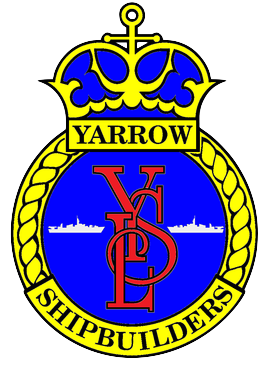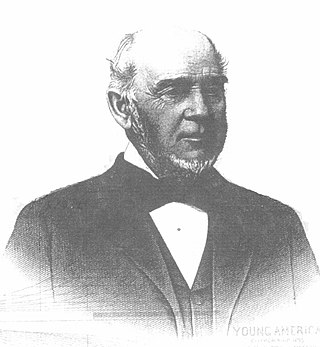Related Research Articles

Saint John is a seaport city located on the Bay of Fundy in the province of New Brunswick, Canada. It is Canada's oldest incorporated city, established by royal charter on May 18, 1785, during the reign of George III. The port is Canada's third-largest by tonnage with a cargo base that includes dry and liquid bulk, break bulk, containers, and cruise. The city was the most populous in New Brunswick until the 2016 census, when it was overtaken by Moncton. It is currently the second-largest city in the province, with a population of 69,895 over an area of 315.59 km2 (121.85 sq mi).

The Bay of Fundy is a bay between the Canadian provinces of New Brunswick and Nova Scotia, with a small portion touching the U.S. state of Maine. It is an arm of the Gulf of Maine. Its tidal range is the highest in the world. The name is probably a corruption of the French word fendu, meaning 'split'.

Yarrow Shipbuilders Limited (YSL), often styled as simply Yarrows, was a major shipbuilding firm based in the Scotstoun district of Glasgow on the River Clyde. It is now part of BAE Systems Surface Ships, owned by BAE Systems, which has also operated the nearby Govan shipyard since 1999.

J. D. Irving Limited (JDI) is a privately owned conglomerate company headquartered in Saint John, New Brunswick, Canada. It is a part of the Irving Group of Companies and consists of various subsidiaries such as Irving Tissue, Irving Equipment, Kent Building Supplies, New Brunswick Railway, New Brunswick Southern Railway, Eastern Maine Railway, Maine Northern Railway, Brunswick News, Acadia Broadcasting, Irving Shipbuilding, and Cavendish Farms, among others. It is involved in many industries including forestry, forestry products, agriculture, food processing, transportation, and shipbuilding. JDI along with Irving Oil, Ocean Capital Investments and Brunswick News, forms the bulk of the Irving Group of Companies, which groups the interests of the Irving family.

William Henry Webb was a 19th-century New York City shipbuilder and philanthropist, who has been called America's first true naval architect.

St. Martins is a community on the Bay of Fundy now part of the village of Fundy-St. Martins, Canada.

Pennellville Historic District is a residential district located in Brunswick, Maine. To locals, the neighborhood is known simply as "Pennellville."

The history of New Brunswick covers the period from the arrival of the Paleo-Indians thousands of years ago to the present day. Prior to European colonization, the lands encompassing present-day New Brunswick were inhabited for millennia by the several First Nations groups, most notably the Maliseet, Mi'kmaq, and the Passamaquoddy.

Davie Shipbuilding is a shipbuilding company located in Lauzon, Quebec, Canada. The facility is now operating as Chantier Davie Canada Inc. and is the oldest continually operating shipbuilder in North America.

The Fundy-class minesweepers were a class of four minesweepers operated by the Royal Canadian Navy during the Second World War. All four ships entered service in 1938 and the class were discarded in 1945, sold for mercantile service. Three ended up sold to Chinese interests, while one remained active in Canada until 1987.

HMCS Fundy was a Fundy-class minesweeper that served in the Royal Canadian Navy from 1938 to 1945. The minesweeper was the first warship built for Canada since 1918. She saw service in the Atlantic Ocean during the Second World War. The vessel was named for the Bay of Fundy. After the war she had an extensive civilian career.
Saint John Shipbuilding was a Canadian shipbuilding company located in Saint John, New Brunswick. The shipyard was active from 1923 to 2003.
Joseph Cunard was a merchant, shipbuilder and political figure in New Brunswick. He represented Northumberland County in the Legislative Assembly of New Brunswick from 1828 to 1833.
The Irving Group of Companies is an informal name given to those companies owned and controlled by the Irving family of New Brunswick—descendants of Canadian industrialist K.C. Irving: his sons James K. (1928–2024), Arthur (1930–2024), and John (1932–2010), and their respective children.
Joseph Salter was a Canadian businessman and politician, becoming Moncton’s first mayor and one of the leading shipbuilders in the Maritime Provinces. As a young man employed by John Leander Starr of Halifax, Salter crossed the Atlantic 36 times. He later built some of the finest and largest ships in Westmorland County. He kept a diary which was published in 1996.
Black Watch was a large full-rigged ship built by Windsor shipbuilder Bennett Smith in Windsor, Nova Scotia. It was the last ship built by Smith in Windsor.

The William D. Lawrence Shipyard built vessels from 1859 until 1903 in Maitland, Nova Scotia. It is most renowned for building the William D. Lawrence in 1874, reported to be the largest wooden ship ever built in Canada and one of the largest in the world at the time. The merchant, shipbuilder and politician William Dawson Lawrence established the yard and built six vessels in it. His brothers Lockhart Lawrence and Thomas Lawrence both built vessels in the Shipyard as well as grandson Captain William Lawrence. The output of the Lawrence yard was relatively modest compared to other ship yards of the Bay of Fundy but Lawrence achieved distinction when he decided to build the William D. Lawrence as a tribute to shipbuilding in the province.

The Pictou Shipyard is a Canadian shipbuilding site located in Pictou County, Nova Scotia, and made famous by its use as an emergency shipbuilding facility in World War II, during which it constructed twenty-four 4,700-ton Scandinavian class freighters.

The Lord Ashburton was a merchant ship built in 1843 at St. Andrews, New Brunswick. She was wrecked in a nor'easter on Grand Manan Island in January 1857 en route from Toulon to Saint John, New Brunswick.

Walter Butler Shipbuilders Inc. was a large-scale World War II ship manufacturing shipyard, located at Superior, Wisconsin, United States. Walter Butler purchased the shipyard from Lake Superior Shipbuilding in 1942. Walter Butler Shipbuilders Inc. was at E 1st St, Superior, Wisconsin. The shipyard was located on the western part of Lake Superior. Walter Butler Shipbuilders Inc. was found by Walter Butler in 1942 to build ships for World War II. Walter Butler Shipbuilders Inc., the McDougall Duluth Shipbuilding Company and the Superior Shipbuilding Company were called the Twin Ports shipbuilding industry of Minnesota and Wisconsin. Once built the ships can travel to the Atlantic Ocean through the Great Lakes and the Saint Lawrence Seaway.
References
- ↑ Wright, Esther Clark (1974). The Ships of St. Martins. Saint John, N.B: The New Brunswick Museum.
- 1 2 3 Fischer, Lewis R. (1979). "The Enterprising Canadians: Entrepreneurs and Economic Development in Eastern Canada, 1820-1914". Proceedings of the Second Conference of the Atlantic Canada Shipping Project, March 30-April 1, 1978. ISBN 9780889010185 . Retrieved 12 March 2014.
- 1 2 Shipbuilding in St. Martins. St. Martins, N.B: Quaco Historical and Library Society, Inc. 1999.